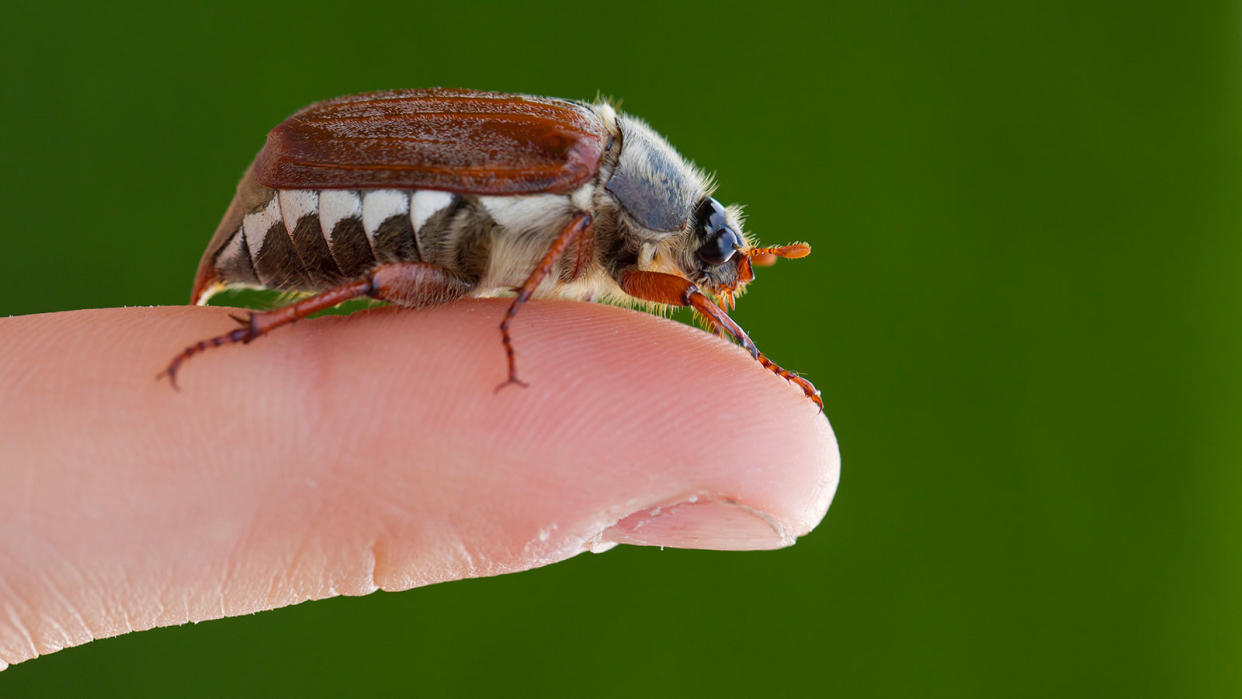The June Bug: Nuisance for People, Manna for Other Animals

Although not as annoying as itchy bump-inducing mosquitoes or stinging wasps, the so-called "June bug," or June beetle, can still bring its own brand of trouble, come late spring.
These beetles, often recognized by their robust bodies and reddish-brown shells, have a peculiar presence in many backyards and outdoor areas. Their behavior, while not as directly bothersome as some other insects, hints at a more complex life cycle and impact on the environment.
The June bug's activities, both seen and unseen, play a distinct role in the ecological balance. From their interaction with light sources to their unseen contributions to the ecosystem, these creatures embody a fascinating aspect of the natural world.
What Is a June Bug?
These beetles are members of the exceptionally diverse family of Scarabaeidae (scarab) beetles, which number more than 30,000 species, 200 of which are North American June beetles. They are about a half-inch (1.27 centimeters) long and with a reddish-brown color. Their scientific name, or genus, is Phyllophaga, which means "leaf eater" in Greek.
These insects are sometimes referred to as May bugs, as they show up at slightly different times depending on their location.
"In our area, they emerge in May and begin laying eggs by June and continuing throughout the summer, the adults will congregate around lights at night," emails David Lofquist, region technical training manager for Arrow Exterminators, which primarily serves the Southeastern United States. "So, the nickname June bug is appropriate."
A couple of June bugs flying around are no big deal, maybe a little annoying.
"For most people, the adults may be a nuisance in the evening hours because they are clumsy fliers and may collide with people, doors, windows and other objects," says Dr. Angela Tucker, entomologist and technical manager with Terminix via email.
June bugs are nocturnal, feeding at night to avoid their many predators, so that's why they become an issue once the sun goes down. They're also attracted to light, which is why they hit the windows.

"They are harmless to us in that they will not bite or sting; however, several species will severely damage crops, turf and ornamentals," Lofquist explains.
This is especially likely if you're dealing with an outbreak of Japanese beetles, which are in the same family as June bugs. These little buggers are an invasive species that wreak havoc on gardens and ornamental trees, as they chew flowers, fruit and leaves down to practically nothing.
June Bugs and Grass
Most of the time, however, the main problem with June bugs actually occurs far before they learn to fly. During the larval stage, these "white grubs" live in the soil, where they feed on the roots of plants and turf grasses, Lofquist notes. "This is bad news for golf courses and lawns," he says.
"June bug larvae cut grass at the roots, leaving behind dry, bald patches in lawns," explains Glen Ramsey, entomologist and technical services manager for Orkin via email.
That's not where the peril of June bug grubs ends, however. "They can destroy several crops like strawberries, corn and potatoes. Their larvae can also attract larger animals like moles and voles that will dig through gardens and yards to hunt them," he adds.
Fortunately, the grub stage is also the easiest to treat. "Lawn areas can be treated with granular products that are labeled for grub control in early summer," Lofquist says. "This will help to minimize turf damage."
Keeping June Bugs Away
Mature June bugs (which have an impressive three-year life cycle), can be handled in a different way if they're getting on your nerves in the evening.
"You can consider changing the outdoor light bulbs to sodium vapor or halogen," Tucker suggests. "Those bulbs will attract fewer flying insects than other bulb types."
Just make sure to check that your light fixtures are compatible with such bulbs, she says. Making this tweak reduces the "beacon effect" that lures beetles toward your home in the evening.
Lofquist of Arrow says the adult bugs are very difficult to control. "Thankfully, these beetles have many natural predators that are abundant in a typical suburban landscape: spiders, snakes, frogs, birds, bats, and rodents all think June beetles are tasty," he says. "They also have several species of parasitic wasps and flies that seek them out on a nightly basis."
In regard to Japanese beetles, there are bag-style traps available to reduce the infestation. "It's best to install them downwind from the garden," Lofquist says. "That way the attractants will lure them into the bag before reaching the garden."
If all else fails, call in a professional to get the issue under control. "Because of the damage and property destruction June bugs and their larvae can cause, it is best to call a pest control professional to manage them sooner rather than later," says Ramsey.
This article was updated in conjunction with AI technology, then fact-checked and edited by a HowStuffWorks editor.
Now That's Important
Not sure if you're dealing with June bugs or Japanese beetles, specifically? The most common June bug is reddish-brown in color and about 0.5 inches to 1 inch (1.27 to 2.5 centimeters) long. Japanese beetles, however, are between 0.3 and 0.5 inches (0.83 and 1.27 centimeters) long. They sport a metallic green head and thorax, as well as copper-colored wing covers.
Original article: The June Bug: Nuisance for People, Manna for Other Animals
Copyright © 2023 HowStuffWorks, a division of InfoSpace Holdings, LLC, a System1 Company


